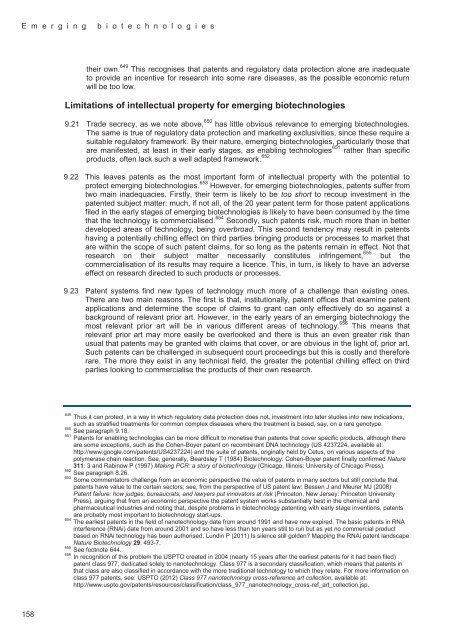Emerging biotechnologies: full report - Nuffield Council on Bioethics
Emerging biotechnologies: full report - Nuffield Council on Bioethics
Emerging biotechnologies: full report - Nuffield Council on Bioethics
Create successful ePaper yourself
Turn your PDF publications into a flip-book with our unique Google optimized e-Paper software.
E m e r g i n g b i o t e c h n o l o g i e s<br />
their own. 649 This recognises that patents and regulatory data protecti<strong>on</strong> al<strong>on</strong>e are inadequate<br />
to provide an incentive for research into some rare diseases, as the possible ec<strong>on</strong>omic return<br />
will be too low.<br />
Limitati<strong>on</strong>s of intellectual property for emerging <str<strong>on</strong>g>biotechnologies</str<strong>on</strong>g><br />
9.21 Trade secrecy, as we note above, 650 has little obvious relevance to emerging <str<strong>on</strong>g>biotechnologies</str<strong>on</strong>g>.<br />
The same is true of regulatory data protecti<strong>on</strong> and marketing exclusivities, since these require a<br />
suitable regulatory framework. By their nature, emerging <str<strong>on</strong>g>biotechnologies</str<strong>on</strong>g>, particularly those that<br />
are manifested, at least in their early stages, as enabling technologies 651 rather than specific<br />
products, often lack such a well adapted framework. 652<br />
9.22 This leaves patents as the most important form of intellectual property with the potential to<br />
protect emerging <str<strong>on</strong>g>biotechnologies</str<strong>on</strong>g>. 653 However, for emerging <str<strong>on</strong>g>biotechnologies</str<strong>on</strong>g>, patents suffer from<br />
two main inadequacies. Firstly, their term is likely to be too short to recoup investment in the<br />
patented subject matter: much, if not all, of the 20 year patent term for those patent applicati<strong>on</strong>s<br />
filed in the early stages of emerging <str<strong>on</strong>g>biotechnologies</str<strong>on</strong>g> is likely to have been c<strong>on</strong>sumed by the time<br />
that the technology is commercialised. 654 Sec<strong>on</strong>dly, such patents risk, much more than in better<br />
developed areas of technology, being overbroad. This sec<strong>on</strong>d tendency may result in patents<br />
having a potentially chilling effect <strong>on</strong> third parties bringing products or processes to market that<br />
are within the scope of such patent claims, for so l<strong>on</strong>g as the patents remain in effect. Not that<br />
research <strong>on</strong> their subject matter necessarily c<strong>on</strong>stitutes infringement, 655 but the<br />
commercialisati<strong>on</strong> of its results may require a licence. This, in turn, is likely to have an adverse<br />
effect <strong>on</strong> research directed to such products or processes.<br />
9.23 Patent systems find new types of technology much more of a challenge than existing <strong>on</strong>es.<br />
There are two main reas<strong>on</strong>s. The first is that, instituti<strong>on</strong>ally, patent offices that examine patent<br />
applicati<strong>on</strong>s and determine the scope of claims to grant can <strong>on</strong>ly effectively do so against a<br />
background of relevant prior art. However, in the early years of an emerging biotechnology the<br />
most relevant prior art will be in various different areas of technology. 656 This means that<br />
relevant prior art may more easily be overlooked and there is thus an even greater risk than<br />
usual that patents may be granted with claims that cover, or are obvious in the light of, prior art.<br />
Such patents can be challenged in subsequent court proceedings but this is costly and therefore<br />
rare. The more they exist in any technical field, the greater the potential chilling effect <strong>on</strong> third<br />
parties looking to commercialise the products of their own research.<br />
649 Thus it can protect, in a way in which regulatory data protecti<strong>on</strong> does not, investment into later studies into new indicati<strong>on</strong>s,<br />
such as stratified treatments for comm<strong>on</strong> complex diseases where the treatment is based, say, <strong>on</strong> a rare genotype.<br />
650 See paragraph 9.18.<br />
651<br />
Patents for enabling technologies can be more difficult to m<strong>on</strong>etise than patents that cover specific products, although there<br />
are some excepti<strong>on</strong>s, such as the Cohen-Boyer patent <strong>on</strong> recombinant DNA technology (US 4237224, available at:<br />
http://www.google.com/patents/US4237224) and the suite of patents, originally held by Cetus, <strong>on</strong> various aspects of the<br />
polymerase chain reacti<strong>on</strong>. See, generally, Beardsley T (1984) Biotechnology: Cohen-Boyer patent finally c<strong>on</strong>firmed Nature<br />
311: 3 and Rabinow P (1997) Making PCR: a story of biotechnology (Chicago, Illinois: University of Chicago Press).<br />
652 See paragraph 8.26.<br />
653<br />
Some commentators challenge from an ec<strong>on</strong>omic perspective the value of patents in many sectors but still c<strong>on</strong>clude that<br />
patents have value to the certain sectors; see, from the perspective of US patent law: Bessen J and Meurer MJ (2008)<br />
Patent failure: how judges, bureaucrats, and lawyers put innovators at risk (Princet<strong>on</strong>, New Jersey: Princet<strong>on</strong> University<br />
Press), arguing that from an ec<strong>on</strong>omic perspective the patent system works substantially best in the chemical and<br />
pharmaceutical industries and noting that, despite problems in biotechnology patenting with early stage inventi<strong>on</strong>s, patents<br />
are probably most important to biotechnology start-ups.<br />
654<br />
The earliest patents in the field of nanotechnology date from around 1991 and have now expired. The basic patents in RNA<br />
interference (RNAi) date from around 2001 and so have less than ten years still to run but as yet no commercial product<br />
based <strong>on</strong> RNAi technology has been authorised. Lundin P (2011) Is silence still golden? Mapping the RNAi patent landscape<br />
Nature Biotechnology 29: 493-7.<br />
655<br />
See footnote 644.<br />
656<br />
In recogniti<strong>on</strong> of this problem the USPTO created in 2004 (nearly 15 years after the earliest patents for it had been filed)<br />
patent class 977, dedicated solely to nanotechnology. Class 977 is a sec<strong>on</strong>dary classificati<strong>on</strong>, which means that patents in<br />
that class are also classified in accordance with the more traditi<strong>on</strong>al technology to which they relate. For more informati<strong>on</strong> <strong>on</strong><br />
class 977 patents, see: USPTO (2012) Class 977 nanotechnology cross-reference art collecti<strong>on</strong>, available at:<br />
http://www.uspto.gov/patents/resources/classificati<strong>on</strong>/class_977_nanotechnology_cross-ref_art_collecti<strong>on</strong>.jsp.<br />
158
















